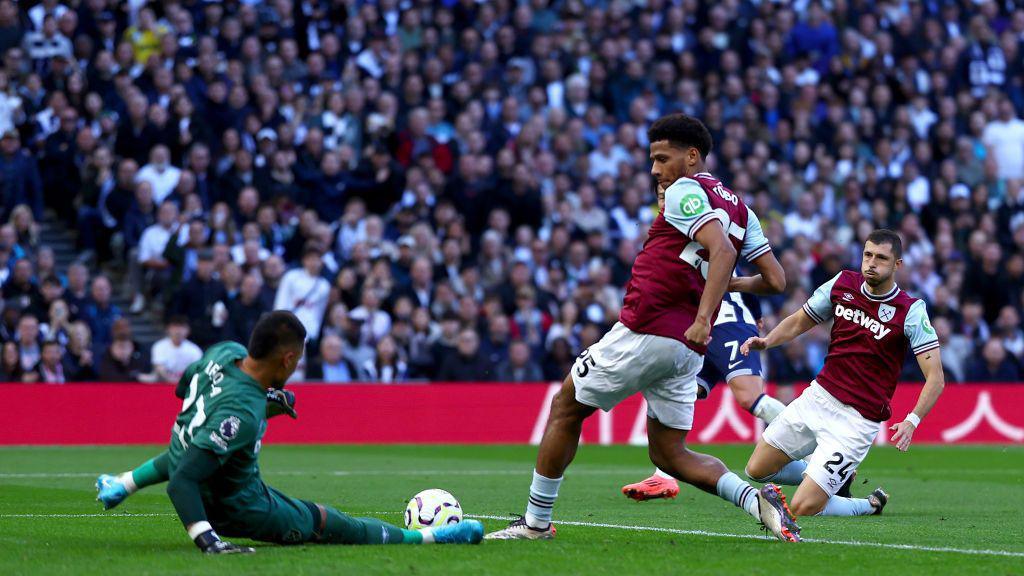What is the dubious goals committee?

- Published
The Premier League and English Football League both use dubious goals committees to determine the identity of goal scorers in instances where it is open to date.
England's top-flight use the Premier League's Goal Accreditation Panel, while the EFL use a Dubious Goals Review.
Initially, the goal scorer is determined by Opta with dubious goals panels then used to determine scorers where it may need further identification.
Taking place at the Premier League Match Centre, the Goal Accreditation Panel is made up of a three person panel. It usually consists of a representative of the Professional Game Match Officials Limited (PGMOL) and two "football experts."
While there is no strict timeline on the accreditation of a goal, a conclusion is sought at the earliest possible convenience, with the priority being on "ensuring the final decisions is correct."
Once a decision is made, it is passed on to data providers Opta and the Premier League's digital team in order for it to be communicated.
Clubs can appeal against a decision to the Premier League's Goal Accreditation Appeals Panel, who will review the footage and come to a decision.
During the 2024-25 season, the Goal Accreditation Panel was used to determine who scored an own goal during a game between Tottenham and West Ham.
Initially given to Jean-Clair Todibo, the panel found that goalkeeper Alphonse Areola was indeed the scorer of the own goal.
While Todibo was the last player to touch the ball, it was the direction of Areola's save that caused the ball to hit Todibo and go in.
Get in touch
Send us your questions
How do goal scorers get identified in the EFL?

During a meeting between Tottenham and West Ham during the 2024-25 Premier League season, an own goal that had initially been credited to Jean-Clair Todibo was later awarded to Alphonse Areola following a review by the Premier League Goal Accreditation Panel
Following an EFL fixture, clubs and the referee are required to submit a team sheet detailing the information from that fixture.
Should there be a discrepancy between those sheets, it will be raised by Opta.
Once submitted, the referee will review the footage and confirm who he thinks the goal was scored by.
If the referee agrees with the club, the team sheet is updated, the club and Opta are informed and a Dubious Goal Review is not required.
If the referee's decision differs from that of the club, the incident is sent for a review.
A Dubious Goals Review is then split into four parts.
First, when there are differing views over if, details of the incident are sent to senior PGMOL officials for review. Any additional evidence by the club is also submitted at this point.
Next, following the review, the EFL's team sheets team will be informed. They will then update the relevant team sheets, inform the match referee, relevant clubs and Opta of the decision.
After that, Opta updates their records and it is up to the club involved to communicate any decision, if they wish to.
The EFL reserves the right to explain processes and clarify any matters in respect of misreporting and misrepresentation around dubious goals.
Clubs can raise a dispute or query regarding a goal after team sheets have been submitted, even if those team sheets initially agreed on the identity of the scorer.
This article is the latest from BBC Sport's Ask Me Anything team.
What is Ask Me Anything?
Ask Me Anything is a service dedicated to answering your questions.
We want to reward your time by telling you things you do not know and reminding you of things you do.
The team will find out everything you need to know and be able to call upon a network of contacts including our experts and pundits.
We will be answering your questions from the heart of the BBC Sport newsroom, and going behind the scenes at some of the world's biggest sporting events.
Our coverage will span the BBC Sport website, app, social media and YouTube accounts, plus BBC TV and radio.